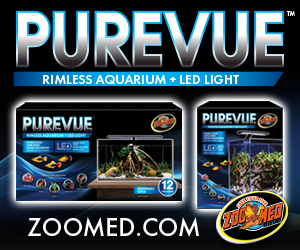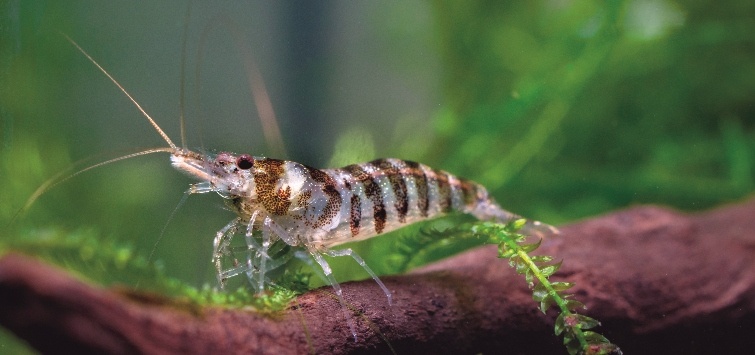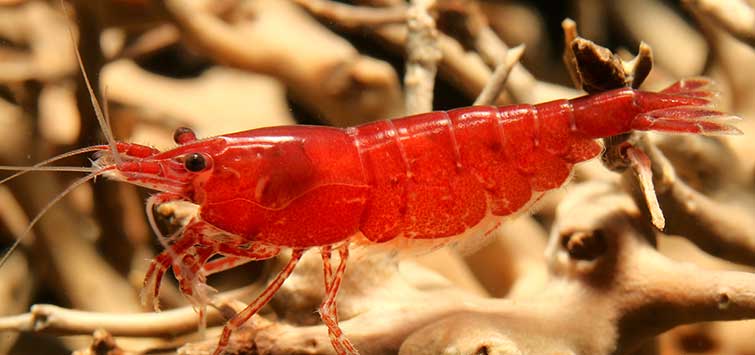Ornamental shrimp can be very rewarding to keep, and a small planted shrimp tank can be a fun project to try. Nano aquariums of about 5 to 8 gallons (about 20 to 30 liters)—or well-managed pico tanks of even smaller volumes—are ideal for keeping shrimp, but their setup needs to be tailored specifically for the task. Plant and hardscape choices need to be practical for a small aquarium, and well selected to show off the tiny inverts within. Filtration is key, and it has to be safely configured in a tank full of little shrimp bodies. It can be surprisingly difficult to get the delicate balance of a small environment right on a small scale the first time out. I will look at getting started with a small dedicated shrimp aquascape with thriving plants to highlight the beauty of the residents and help them thrive.
The Shrimp Aquarium
.jpg)
Choose an aquarium at the very least over 1½ gallons (5.5 liters). Some tanks are sold that are even smaller, but while shrimp can live in relatively small quarters, it is exceptionally difficult to maintain a stable environment any smaller than that. Plus, you want to give them some space to explore, molt, and breed, and a larger enclosure will also provide a greater area for planting and aquascaping. So I recommend going a bit larger.
Many smaller tanks these days have a sectioned-off area on the back wall with inlet and outlet spaces built in, and baffles in most cases. These are terrific for hiding filters and heaters, providing a lot more filtration capacity. I personally like to use a small impeller with tubing directed to the outlet, packing most of the baffled area in front with high-capacity media and leaving space at the inlet section for a small heater.
A small custom-cut piece of fine sponge covering the inlet will usually stop most babies from getting into the area. That said, some may still do so. It won’t harm them getting stuck back there, but take care when rinsing your filter media that you’re not washing away any little ones. Using a white or light-colored bucket is quite good for helping with this.
Otherwise, a small sponge filter is also a good option, as are very small internal powerheads, or hang-on-back (HOB) filters. Here again, make sure to cover all filter and/or pump intakes with a fine-grade sponge or stocking so babies don’t get sucked into the impeller unit, and always check any rinse water before discarding.
Any HOB filter inlets or internal filters (sponge or powerhead) can often be hidden with a flat stone or creative planting, as long as they are accessible to remove and clean. Try to find the smallest heater possible for these little tanks, some for betta aquariums can work well here.
In fact, I have found the all-in-one betta aquariums in the 1½- to 3-gallon (5.5- to 12-liter) range can be the perfect size and come with everything a good shrimp tank needs. In fact, I find the smallest of these more suited to shrimp and small inverts, as I generally keep bettas in larger tanks.
If the space you are keeping the tank is consistently warm year-round, you can try going without heaters, and you might even be able to skip the filter if you plant heavily. Heavy planting can easily provide enough oxygen to keep shrimp happy if given proper lighting and growing conditions.
You can also get creative with novel containers for your shrimp aquariums; large glass bowls or wide vases used for plant terrariums can look very nice, and those with cork or wood lids/toppers can reduce evaporation. Open-top vessels can work fine also, just leave the water a little bit below the top to prevent shrimp crawling or jumping out. For open-top tanks, and especially large vases, emergent plants can look very attractive, and heavy root-feeding emergent plants will do a good job of consuming mulm over time. Just be sure that whatever tank or other container you choose is maintained with at least 1½ gallons (5.5 liters) of water, and it should be wide enough to fit your open hand for hardscaping, maintenance, and cleaning.
Hardscaping for Shrimp
.jpg)
Once you’ve chosen your setup, it is time to decide on a layout. While shrimp sand and other substrates designed with shrimp in mind are common and very good products, useful for buffering pH and providing helpful nutrients, good maintenance should also be able to serve the same functions. Shrimp sand can also be very light and easy to strew about when cleaning, which can upset an aquascape and even dislodge rooted plants.
A layer of shrimp sand can be handy under a layer of heavier gravel if you like using that substrate. A good general start for the heavier layer is basic pea gravel, or better yet, a very fine gravel to match the tiny scale of the shrimp.
Dark substrates tend to look best for showing off shrimp colors, and some shrimp tend to pale when kept against lighter substrates. However, light colors can also look good against dark or deeply colored shrimp varieties, and also the greens of plants, so white aquascaping sand can certainly look stunning in a small planted shrimp tank.
Sand does not make the best planting media; it works best if laid on top of other media, or in a limited area such as an open space at the front or forming a front-to-back path. If sand is the only substrate used, rooting plants don’t tend to thrive, so it’s best to stick to epiphytes or floating plants in a sand-bottomed tank.
Sand also can become anaerobic after time, and so it is best lightly aerated every few weeks (or better yet, at every cleaning) by lightly dragging a thin skewer through the substrate. Any other substrates not specifically made for plants are also best treated the same, though they are less prone than sand to becoming anaerobic quickly. Any areas left to become anaerobic in a shrimp tank are dangerous, as they can release hydrogen sulfide—rotten-egg gas—so it’s good to keep an eye on this.
After deciding on substrate, it’s time to select hardscape. It is best to choose rocks and wood with a lot of fine details, as this helps to keep a sense of scale for the tank and its shrimp residents. Try creating a layered group of finely patterned granite stones with jagged edges clustered in the style of boulders or mountains, with small matching pieces of gravel as “fallen rocks” at the base.
For driftwood, choose small twigs or detailed stumps with lots of twists, cracks and gnarled areas. Long twigs reaching up across the tank can provide a good sense of height, and also something for the shrimp to walk up and display on.
Conversely, if you want to highlight the tiny size of the shrimps, you can create a layout like a slice of normally sized river by choosing larger driftwood pieces and/or a few larger stones or smooth river pebbles. Just be sure that the sizes are consistent. If you intend to keep emerging plants, you should maintain an open area for them. Tall trunks of plants such as lucky bamboo (Dracaena braunii) can also look good as a kind of emergent hardscape. Keep an open area at the front where you can drop shrimp pellets and algae wafers for them to feed on, and where you can easily suck up any leftovers with a wide-mouthed pipette or plastic syringe.
Plants for a Shrimp Aquascape
As with the rest of the layout, aim to choose plants with either small, delicate details to match a tiny-scale world, or larger leaves to complement regular sized river pebbles and driftwood pieces. In a small enclosure space is very limited, so more than a few plant species won’t normally establish well and can look overcrowded and unnatural. Aim for one to five species maximum, for effect.
For an easier setup, a single plant species can look very effective. If you choose more, aim for having one in the foreground, one or two in the rear and/or around the hardscape, maybe a feature plant as a focal point, and maybe a floating species at the surface.
There are many options, but this is a good general guideline for starting out. Contrasting foliage is also a plus for looks, with some good choices for the foreground including pygmy chain sword (Helanthium tenellum), Blyxa japonica, dwarf baby tears (Hemianthus callitrichoides), Glossostigma elatinoides, or dwarf hairgrass (Eleocharis parvula), and they will spread well in most substrates. With bright lighting in shallow tanks, compact growth will be encouraged, and a small amount of liquid fertilizers (including “liquid CO2” type additives) should help keep things happy and green. Some CO2 injection may help well with carpeting plants, but see how things go before trying this.
Mosses, like Java moss (Vesicularia dubyana), can look excellent around rockwork or tied to hardscape in the midground. Stem plants such as Ludwigia repens, L. arcuata, L. repens x arcuata, and Rotala rotundifolia var “indica” can add color in the background, but they may need to be trimmed to stay under control.
Floating plants such as Riccia fluitans, Azolla spp., and common duckweed (Lemna minor) can make good floating plants to add interest to the surface, and shrimp will often hang upside-down from them, allowing the shrimp to occupy all levels of the aquarium.
For larger-scale designs, aim for plants with broader leaves that will give shrimp nice big platforms to walk over and help them be more easily seen. As always, use a good mix of contrasting foliage colors and shapes. But be careful with using larger-leaved plants, as they may quickly become too big for the tank.
If you use plants that may grow too large, containing their roots in small pots so the plants can be easily removed and divided may help a great deal. Pulling plants with extensive root systems out of the substrate risks pulling up the entire floor of the aquarium, destroying the shrimp aquascapeand unleashing an enormous ammonia spike. Large plants can also be cut back by cutting stems/leaves off near the base and leaving some of the plant, and the root system, intact. Do not cut a whole plant down this way, as if the root system dies it can foul the substrate and quickly make the tank go toxic.
Happily, any epiphytes can usually be cut back with a carefully held pair of narrow, sharp scissors, or a razor blade, to slice through the rhizome. If it is attached to a surface, carefully hold the piece of hardscape and pull the plant away if you can, or just cut into the rhizome and remove it.
Epiphytic plants like Anubias can be reattached in other areas or used in other aquariums. Java fern that gets too big can be carefully removed, with any baby plants detached and replanted back in the shrimp tank to keep things on the miniature side. Small Anubias varieties like Anubias barteri var “nana petite” and smaller variants of Java fern (Microsorum pteropus), such as needle leaf and Windelov, can look best, as they are generally smaller and more delicate than regular varieties.
Plants for the midground that will root well and spread for a lush look in a smaller tank include dwarf Sagittaria (Sagittaria subulata), as well as Cryptocoryne species including C. affinis, C. aponogetifolia, C. crispatula var. balansae, C. wendtii, C. beckettii, C. walkeri, and C. undulata.
Mosses and susswassertang can also fill gaps and look attractive. Floating plants such as hornwort (Ceratophyllum demersum) or frogbit (Limnobium laevigatum) can finish off this look well. For an open-topped aquarium, having plants such as lucky bamboo or devil’s ivy (Epipremnum aureum) can look fantastic, with “tree trunks” of lucky bamboo submerged for shrimp to climb on, or long roots of ivy creating interesting tangles underwater while large leaves spill over the top.
Such heavy-feeding plants can also ensure the substrate will rarely need to be disturbed, and they will do a lot to reduce nitrates. This said, the tiny bioload of shrimp may not be enough to keep the plants fed, so do fertilize well if any signs of nitrogen or other deficiency are noticed. A broad general liquid fertilizer will generally do well to keep these plants healthy.
Shrimp Keeping Basics
.jpg)
While the detailed care instructions for specific ornamental shrimps are outside the scope of this article, maintaining water chemistry to suit them is generally similar for most shrimp species and varieties. The various forms of Neocaridina davidi (including the various cherry and rili shrimps) and Caridina cantonensis (including the various bee, crystal red, and tiger shrimps) are generally the most commonly kept. The red cherry shrimp (RCS) is generally what most start with, and they are the hardiest regarding water quality. They will adapt to most healthy conditions within the normal range for tropical fish. They can tolerate temperatures a bit cooler than tropical, thriving in water down to about 65°F (18°C) and even tolerating temperatures down to about 59°F (15°C), but this is not best for them long term.
Maintaining a moderate KH is also important to help ensure their proper shell development, and small amounts of calcium carbonate or crushed coral/shells in the filter can help with this.
The bee shrimps are a little more difficult, preferring their water slightly acidic, with a pH ranging from 6.5 to 7; pH levels any lower than that may cause small holes or pitting in their shells.
Nitrates are especially toxic to Caridina shrimp, so maintain a moderate stocking level or keep up water changes and quality filtration to keep nitrates low. Feeding is similar for both genera of shrimp. Their diet should include a variety of high-quality foods such as premium fish flakes or pellets, shrimp pellets, algae wafers, high-protein powdered baby shrimp food, and be sure to leave in some older decomposing leaves from your aquarium plants, as these are natural foods for shrimp. If dead aquatic plant leaves look too messy for you, try adding a few pieces of dead and completely dried leaves of trees such as beech, almond, or oak. Your best bet is to allow your shrimp colony to graze on detritus, microscopic algal films, dead leaves from aquatic plants, and their old molted shells, which are highly nutritious.

.png?h=595&iar=0&w=2781&hash=5FD5E69473BCC22199FBFA2FB71B6033)
.jpg?h=355&iar=0&w=755&hash=EA2FDF4676ECC8CE019EB4DE342D0EE8)


